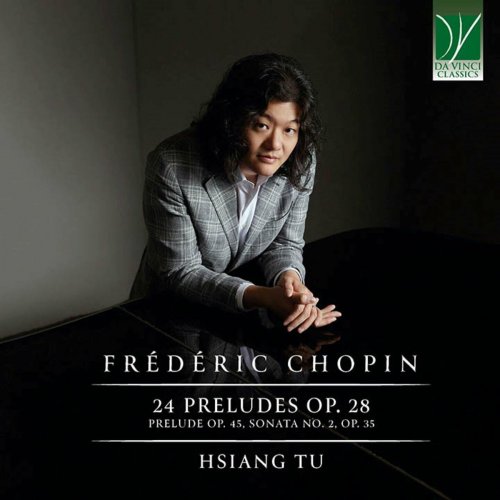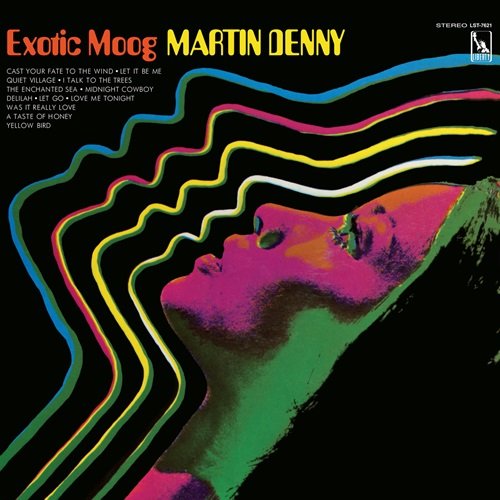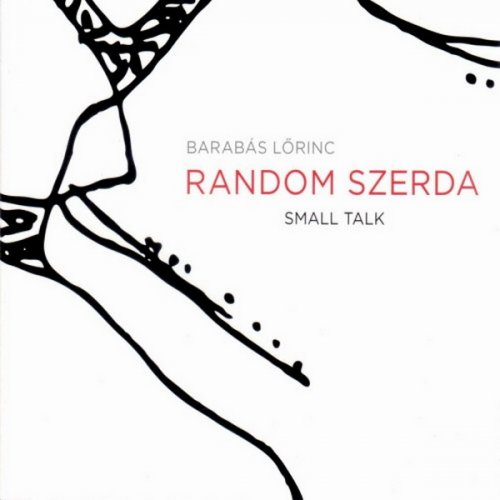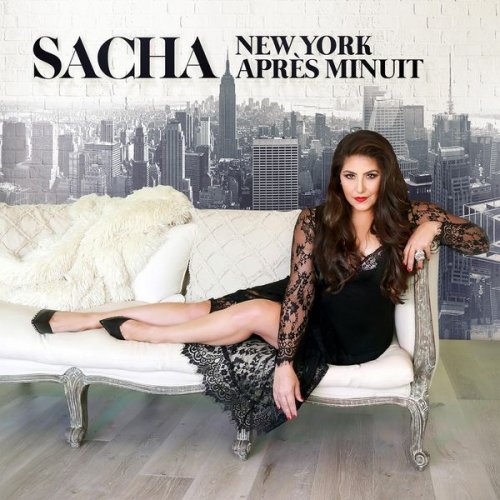Artist:
Hsiang Tu
Title:
Chopin: 24 Preludes Op. 28, Prelude Op. 45, Sonata No. 2, Op. 35
Year Of Release:
2024
Label:
Da Vinci Classics
Genre:
Classical
Quality:
FLAC (tracks)
Total Time: 72:15min
Total Size: 227 MB
WebSite:
Album Preview
Tracklist:01. 24 Preludes, Op. 28: No. 1 in C Major, Agitato
02. 24 Preludes, Op. 28: No. 2 in A Minor, Lento
03. 24 Preludes, Op. 28: No. 3 in G Major, Vivace
04. 24 Preludes, Op. 28: No. 4 in E Minor, Largo
05. 24 Preludes, Op. 28: No. 5 in D Major, Allegro molto
06. 24 Preludes, Op. 28: No. 6 in B Minor, Lento assai
07. 24 Preludes, Op. 28: No. 7 in A Major, Andantino
08. 24 Preludes, Op. 28: No. 8 in F-Sharp Minor, Molto agitato
09. 24 Preludes, Op. 28: No. 9 in E Major, Largo
10. 24 Preludes, Op. 28: No. 10 in C-Sharp Minor, Allegro molto
11. 24 Preludes, Op. 28: No. 11 in B Major, Vivace
12. 24 Preludes, Op. 28: No. 12 in G-Sharp Minor, Presto
13. 24 Preludes, Op. 28: No. 13 in F-Sharp Major, Lento
14. 24 Preludes, Op. 28: No. 14 in E-Flat Minor, Allegro
15. 24 Preludes, Op. 28: No. 15 in D-Flat Major, Sostenuto
16. 24 Preludes, Op. 28: No. 16 in B-Flat Minor, Presto con fuoco
17. 24 Preludes, Op. 28: No. 17 in A-Flat Major, Allegretto
18. 24 Preludes, Op. 28: No. 18 in F Minor, Allegro molto
19. 24 Preludes, Op. 28: No. 19 in E-Flat Major, Vivace
20. 24 Preludes, Op. 28: No. 20 in C Minor, Largo
21. 24 Preludes, Op. 28: No. 21 in B-Flat Major, Cantabile
22. 24 Preludes, Op. 28: No. 22 in G Minor, Molto agitato
23. 24 Preludes, Op. 28: No. 23 in F Major, Moderato
24. 24 Preludes, Op. 28: No. 24 in D Minor, Allegro appassionato
25. Prelude in C-Sharp Minor, Op. 45
26. Piano Sonata No. 2 in B-Flat Minor, Op. 35: I. Grave - Doppio movimento
27. Piano Sonata No. 2 in B-Flat Minor, Op. 35: II. Scherzo - Più lento - Tempo I
28. Piano Sonata No. 2 in B-Flat Minor, Op. 35: III. Marche funèbre. Lento - IV. Finale. Presto
In a 1919 poem entitled “Chopin,” the American poet Amy Lowell dramatized her struggles with writer’s block by drawing parallels between the unsuccessful mousing of her cat Winky, her own lack of ideas, and the tubercular Chopin’s temporarily unsuccessful attempts to get the Préludes on paper in Majorca in the winter of 1838-1839. After describing a dramatic landscape of the desolate, wind and rain-lashed island, Lowell drew on Chopin’s letters, describing a composer who spit blood:
Music quenched in blood, / Flights of arpeggios confused by blood, / Flute-showers of notes stung and arrested on a sharp chord, / Tangled in a web of blood. / “I cannot send you the manuscripts, as they are not yet finished. / I have been ill as a dog, / My illness has had a pernicious effect on the Preludes which you will receive God knows when.”
(Selected Poems of Amy Lowell, 98)
She notes that “[Chopin] bore it,” and so shall she and Winky; they will return to their labors on the morrow.
The Polish composer’s sojourn with George Sand on Majorca has always fascinated music lovers, likely due to its erotic implications; the romantic pairing of two important figures, one literary, one musical, sparked numerous depictions in literature and later, in film. The factually-challenged Hollywood bio-pic A Song to Remember (1945) depicts Sand as a wicked siren luring Chopin into the life of an elegant but vapid salon composer, using Majorca as the bait. “You could write miracles of music in Majorca,” she gasps before being seized by Chopin for a kiss. In the following scene, she dismisses his work as a performer, saying “Your genius is creating music for smaller men to play.” The pants-wearing Sand encourages Chopin to write effeminate salon music; she is enraged when she catches him working on “this so-called polonaise jumble,” referring to the Polonaise, op. 53. The screenwriters thus create a neat divide between Chopin’s salon “trifles” and his more lengthy piano works.
20th century pianists such as Ignaz Friedman and Arthur Rubinstein were eager to emphasize their energetic interpretations of the polonaises, scherzi, ballades, sonatas, and the complete préludes. Rubinstein in particular claimed in his memoirs that previous generations of pianists had offered up a sickly, drawing room Chopin, whereas *his* performances were masculine, catching more of the spirit of the fiery, patriotic Chopin. This narrative of 19th v. 20th century Chopin performance practice has now become accepted as fact (ignoring the documented performances or recordings of firebrand pianists such as Anton Rubinstein and his pupil Josef Hofmann, neither of whom were famous for their tame Chopin); this notion of the need to play Chopin’s music in a muscular fashion is intricately bound up with our understanding of how his music should be programmed, particularly when it comes to the twenty-four préludes written in Majorca.
Modern pianists almost never program individual préludes on their programs, instead opting to play the entire set, a significant undertaking that usually lasts roughly 45 minutes. It is worth noting that Chopin himself never attempted this sort of marathon; his top prélude score was a performance of six préludes as a group on a single program. His 1842 recital at the Salle Pleyel in Paris included five of the op. 28 préludes (nos. 4, 9, 11, 13, 15) and the op. 45 prélude, situated among handfuls of nocturnes, études, the Ballade no. 3, the Andante Spianato (shorn of its polonaise), and other pieces. Does Chopin’s avoidance of a complete préludes rendition mean that pianists should be solely picking and choosing small groups of préludes for their programs?
The complete performances that have become the norm indicate that although individual préludes can work well as part of a selected bouquet, they do function admirably as an integral unit with 24 related parts. Chopin groups the préludes by key: the first pair are in C Major and the relative minor of A Minor (no sharps or flats); the second pair are in G Major and E Minor (one sharp). He continues in this fashion, working his way through the keys until he reaches the final pair, F Major and D minor (one flat). Perhaps anticipating that pianists might some day be inclined to program the entire set, Chopin has designed a flow that moves from the generous to the suffocating, from dramatic to jovial. As a theatrical progression, it works superbly. On the other hand, he has not been particularly kind to the pianist who for example plans to negotiate the lightning unisons of no. 18 and follow it immediately with the awkward and frankly nasty no. 19.
Given the aphoristic nature of the préludes, it is tempting to embrace the thinking of pianists like Hans von Bülow or Alfred Cortot, who each assigned poetic names to each prélude. (von Bülow gave no. 15 its famous “Raindrop” sobriquet, while Cortot bestowed upon it the more dramatic title of “But death is here, in the shadows.”) Some listeners may need titles to help make sense of these fleeting, histrionic tidbits and should be encouraged to devise their own or seek out those of von Bülow or Cortot. Others can be content with Chopin’s ever-changing textures, impressive technical hurdles, significant mood swings, and deep emotional content.
The Sonata no. 2 op. 35, with its famous “Funeral March,” was written roughly contemporaneously with the préludes, the préludes being written between 1835 and 1839, the sonata being composed within the same time frame. There are some compositional parallels to be found between the two works, the most notable being the striking similarity between the 14th prélude and the final movement of the sonata; the famous “wind over the graves” parallel motion between the hands of the finale is duplicated in the prélude, though the latter is mercifully shorter and marked ‘Allegro’ rather than ‘Presto.’ Hsiang Tu hears a close relationship between the “Raindrop” prélude and the B section of the funeral march (also in D-flat Major). Tu notes that for Chopin, D-flat Major is the key of tenderness, citing also the famous Nocturne op. 27 no. 2.
The sonata has been a staple of the repertoire since its composition. Chopin, who knew the value of a good tune, himself happily excerpted the march on his recitals but was often so overcome by his emotions after playing it that he could not continue. The march’s out-of-control 19th-century popularity as a literal funeral march played by brass bands trudging in the vanguard of the funeral procession of deceased public figures cemented its position as a musical shorthand for death or dying. The march is of course not all there is to the sonata. The first movement in particular has triggered significant comment amongst musicians over the placement of the repeat sign in the exposition. Should the pianist return to the first bar, repeating the short Grave section, or instead begin again with the fifth bar? The late musicologists Edward T. Cone and Charles Rosen vehemently insisted that the printed editions that show a return to the fifth bar (the vast majority) are incorrect, but most modern pianists ignore their pleas, remaining with the traditional repeat sign in the fifth bar. It is worth noting that a major 19th-century edition of the sonata shows the repeat returning to the first bar: that of Johannes Brahms. On this recording, Hsiang Tu returns to the first bar; he has cited his understanding of the II-V nature of the first ending and the conclusive nature provided by a move to D-flat rather than the B-flat found five bars later as the reason for his decision.
Amy Lowell resolved her writer’s block by composing a poem about it, Chopin’s illness serving as an inspiration. For his part, Chopin completed his préludes and continued to compose for another decade before succumbing to tuberculosis. However much he suffered, the creations of this period stand as cornerstones of his output, being among the best-loved of his many compositions.



![Gonzalo Rubalcaba - Gonzalo Plays PIino (2025) [Hi-Res] Gonzalo Rubalcaba - Gonzalo Plays PIino (2025) [Hi-Res]](https://www.dibpic.com/uploads/posts/2025-12/1766206867_folder.jpg)




![Brad Keeghan - Brad Keeghan (2025) [Hi-Res] Brad Keeghan - Brad Keeghan (2025) [Hi-Res]](https://www.dibpic.com/uploads/posts/2025-12/1766078373_cover.jpg)
![Ready Player 3 - Ready Player 3 (2025) [Hi-Res] Ready Player 3 - Ready Player 3 (2025) [Hi-Res]](https://www.dibpic.com/uploads/posts/2025-12/1766128773_cover.jpg)
![Richard Carr, Czech National Symphony Orchestra, Vladimir Martinka - Richard Carr: The Leap (2025) [Hi-Res] Richard Carr, Czech National Symphony Orchestra, Vladimir Martinka - Richard Carr: The Leap (2025) [Hi-Res]](https://img.israbox.com/img/2025-12/22/0ruhq82oeu9h4oypzf8u61qbv.jpg)